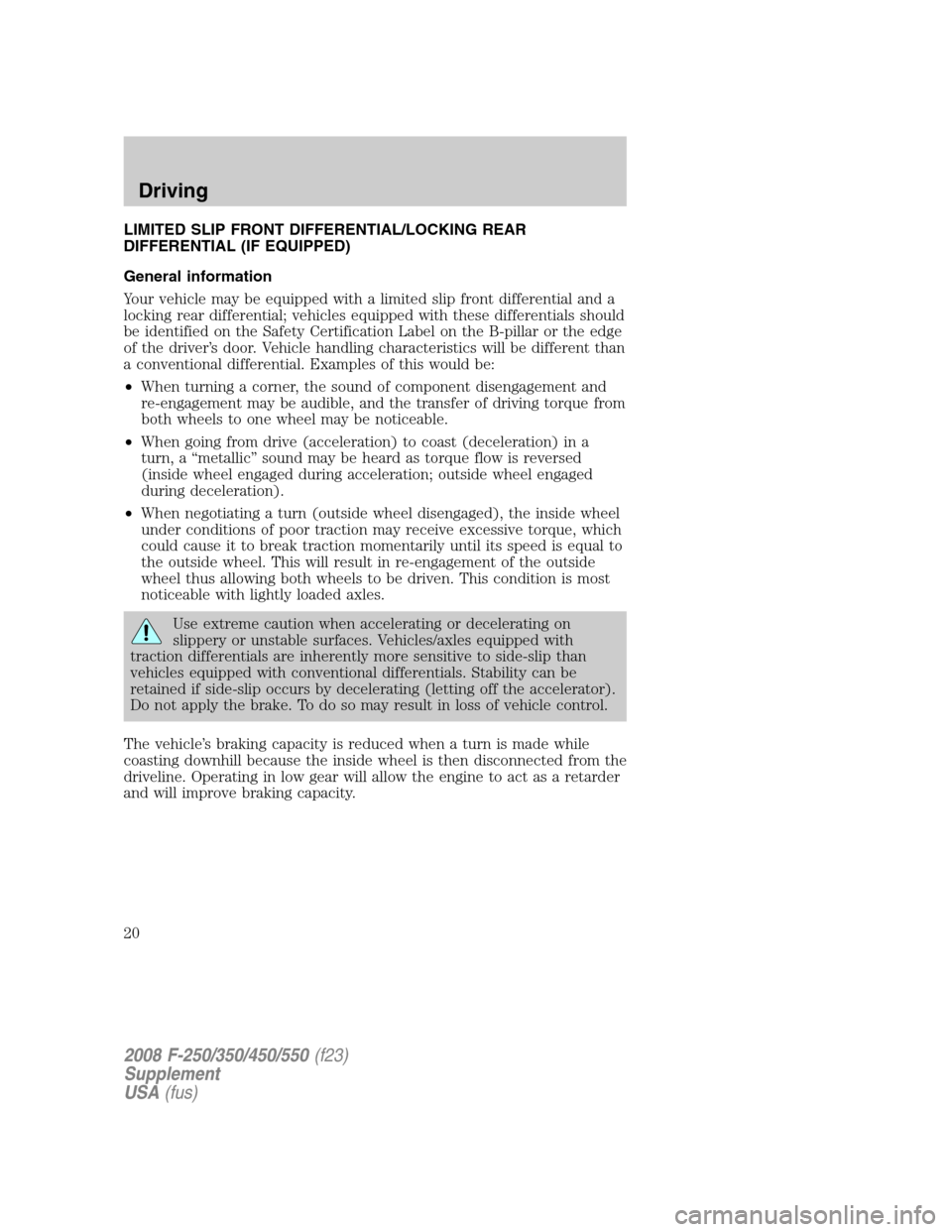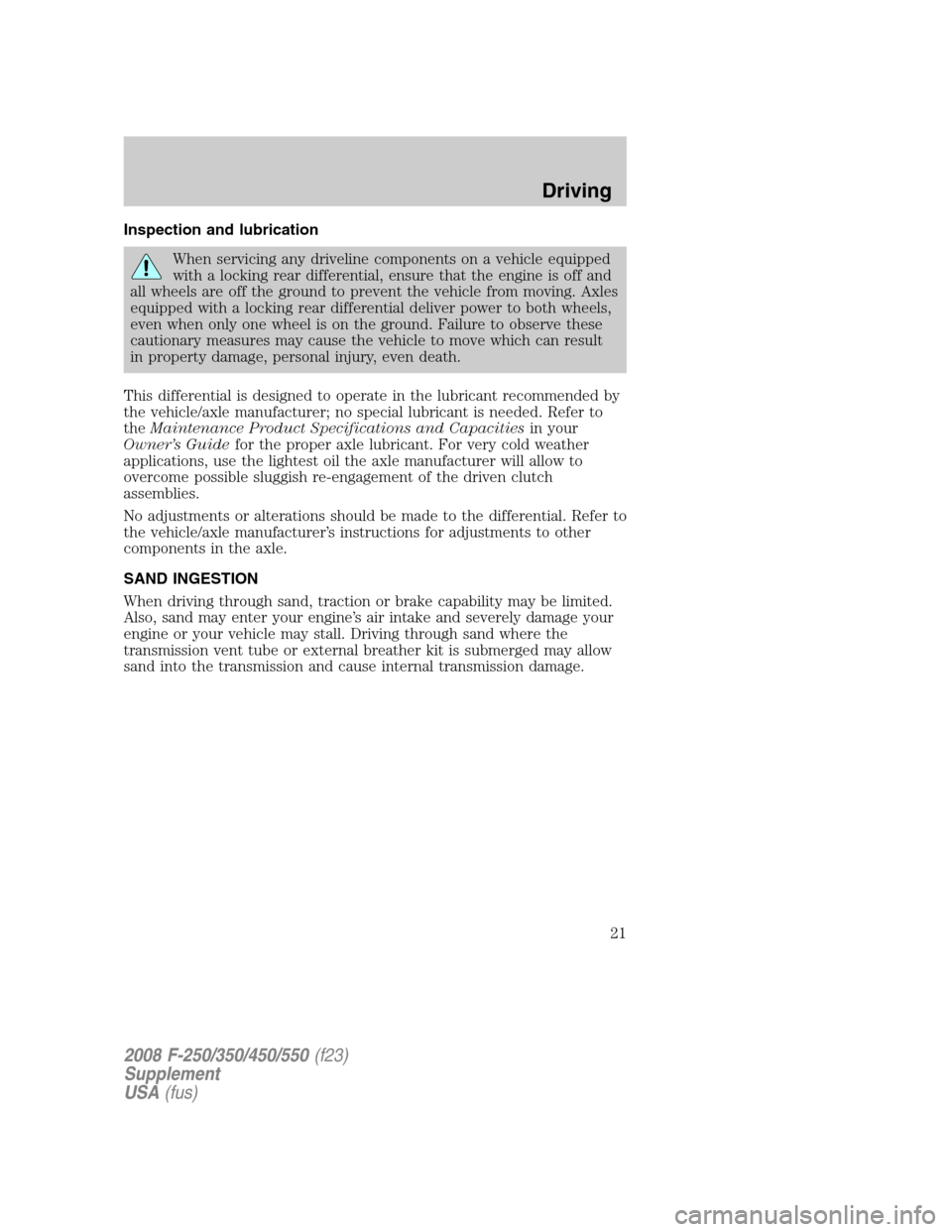differential FORD SUPER DUTY 2008 2.G Special Off-Road Package Supplement Manual
[x] Cancel search | Manufacturer: FORD, Model Year: 2008, Model line: SUPER DUTY, Model: FORD SUPER DUTY 2008 2.GPages: 25, PDF Size: 0.2 MB
Page 20 of 25

LIMITED SLIP FRONT DIFFERENTIAL/LOCKING REAR
DIFFERENTIAL (IF EQUIPPED)
General information
Your vehicle may be equipped with a limited slip front differential and a
locking rear differential; vehicles equipped with these differentials should
be identified on the Safety Certification Label on the B-pillar or the edge
of the driver’s door. Vehicle handling characteristics will be different than
a conventional differential. Examples of this would be:
•When turning a corner, the sound of component disengagement and
re-engagement may be audible, and the transfer of driving torque from
both wheels to one wheel may be noticeable.
•When going from drive (acceleration) to coast (deceleration) in a
turn, a “metallic” sound may be heard as torque flow is reversed
(inside wheel engaged during acceleration; outside wheel engaged
during deceleration).
•When negotiating a turn (outside wheel disengaged), the inside wheel
under conditions of poor traction may receive excessive torque, which
could cause it to break traction momentarily until its speed is equal to
the outside wheel. This will result in re-engagement of the outside
wheel thus allowing both wheels to be driven. This condition is most
noticeable with lightly loaded axles.
Use extreme caution when accelerating or decelerating on
slippery or unstable surfaces. Vehicles/axles equipped with
traction differentials are inherently more sensitive to side-slip than
vehicles equipped with conventional differentials. Stability can be
retained if side-slip occurs by decelerating (letting off the accelerator).
Do not apply the brake. To do so may result in loss of vehicle control.
The vehicle’s braking capacity is reduced when a turn is made while
coasting downhill because the inside wheel is then disconnected from the
driveline. Operating in low gear will allow the engine to act as a retarder
and will improve braking capacity.
2008 F-250/350/450/550(f23)
Supplement
USA(fus)
Driving
20
Page 21 of 25

Inspection and lubrication
When servicing any driveline components on a vehicle equipped
with a locking rear differential, ensure that the engine is off and
all wheels are off the ground to prevent the vehicle from moving. Axles
equipped with a locking rear differential deliver power to both wheels,
even when only one wheel is on the ground. Failure to observe these
cautionary measures may cause the vehicle to move which can result
in property damage, personal injury, even death.
This differential is designed to operate in the lubricant recommended by
the vehicle/axle manufacturer; no special lubricant is needed. Refer to
theMaintenance Product Specifications and Capacitiesin your
Owner’s Guidefor the proper axle lubricant. For very cold weather
applications, use the lightest oil the axle manufacturer will allow to
overcome possible sluggish re-engagement of the driven clutch
assemblies.
No adjustments or alterations should be made to the differential. Refer to
the vehicle/axle manufacturer’s instructions for adjustments to other
components in the axle.
SAND INGESTION
When driving through sand, traction or brake capability may be limited.
Also, sand may enter your engine’s air intake and severely damage your
engine or your vehicle may stall. Driving through sand where the
transmission vent tube or external breather kit is submerged may allow
sand into the transmission and cause internal transmission damage.
2008 F-250/350/450/550(f23)
Supplement
USA(fus)
Driving
21